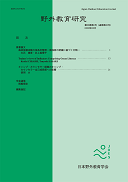
- Issue 2 Pages 1-
- Issue 1 Pages 1-
- |<
- <
- 1
- >
- >|
-
―For Theorizing of “Community-based Outdoor Education”―Kazushi MAETA2016 Volume 19 Issue 2 Pages 1-13
Published: 2016
Released on J-STAGE: December 29, 2018
JOURNAL FREE ACCESSRecently, there has been a debate about possibilities of outdoor education to promote sustainability of our societies and natural environment. An attempt of theorizing and practice of “Community-based Outdoor Education” was one of the responses to the debate. But it should be re-constructed through understanding recent and broader discussion of education in place. I'm trying to understand a research of “Place-Responsive Outdoor Education” discussed on “A Pedagogy of Place: Outdoor Education for a Changing World” by Brian Wattchow and Mike Brown. According to them, place isn't merely space. Place is generated by interaction between terrain, ecosystem, fauna and flora, communities, policy and history of land use, and so on. Even if the place is natural area, it must be culturally constructed. It promotes educators and participants to give whole mind to stories embedded in the place. And it makes them to understand thoughtfully interaction of factors generating the place. Their purpose is to re-create theories and practices of outdoor education through tying them up with global change of environment and society.
View full abstractDownload PDF (3926K)
-
Takahiro ICHIKAWA2016 Volume 19 Issue 2 Pages 14-21
Published: 2016
Released on J-STAGE: December 29, 2018
JOURNAL FREE ACCESSThe purpose of this study was to clarity change in air dose rate with time series variations on the mountain trails of Mt. Takahara from October 2011 to November 2015. The air dose rates at a height of 1m in November 2015 were 0.3-0.4 times lower than those in October 2011. At investigation sites, the air dose rates decreased with natural decay, and were less than 0.23 μSv/h in November 2015, in endemic spruce, where the air dose rate was higher than that at other sites. This suggested that aerial radioactive materials were trapped on the canopy of the endemic spruce through cloud water deposition. During a hike to Mt. Takahara, the level of radioactive exposure was 0.001 mSv, and it returned to daily life in November 2015.
View full abstractDownload PDF (2218K)
- |<
- <
- 1
- >
- >|